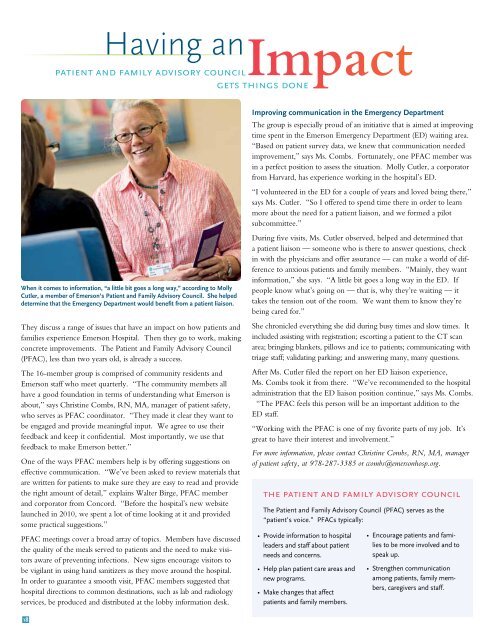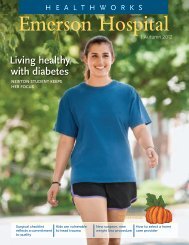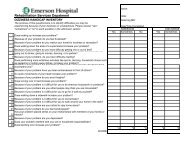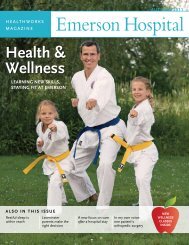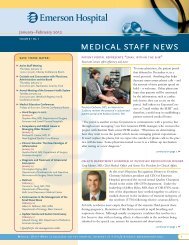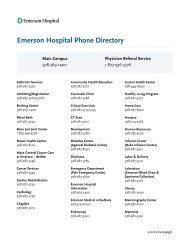You also want an ePaper? Increase the reach of your titles
YUMPU automatically turns print PDFs into web optimized ePapers that Google loves.
Having anImpactpatient and family advisory councilgets things doneWhen it comes to information, “a little bit goes a long way,” according to MollyCutler, a member of <strong>Emerson</strong>’s Patient and Family Advisory Council. She helpeddetermine that the Emergency Department would benefit from a patient liaison.They discuss a range of issues that have an impact on how patients andfamilies experience <strong>Emerson</strong> <strong>Hospital</strong>. Then they go to work, makingconcrete improvements. The Patient and Family Advisory Council(PFAC), less than two years old, is already a success.The 16-member group is comprised of community residents and<strong>Emerson</strong> staff who meet quarterly. “The community members allhave a good foundation in terms of understanding what <strong>Emerson</strong> isabout,” says Christine Combs, RN, MA, manager of patient safety,who serves as PFAC coordinator. “They made it clear they want tobe engaged and provide meaningful input. We agree to use theirfeedback and keep it confidential. Most importantly, we use thatfeedback to make <strong>Emerson</strong> better.”One of the ways PFAC members help is by offering suggestions oneffective communication. “We’ve been asked to review materials thatare written for patients to make sure they are easy to read and providethe right amount of detail,” explains Walter Birge, PFAC memberand corporator from Concord. “Before the hospital’s new websitelaunched in 2010, we spent a lot of time looking at it and providedsome practical suggestions.”PFAC meetings cover a broad array of topics. Members have discussedthe quality of the meals served to patients and the need to make visitorsaware of preventing infections. New signs encourage visitors tobe vigilant in using hand sanitizers as they move around the hospital.In order to guarantee a smooth visit, PFAC members suggested thathospital directions to common destinations, such as lab and radiologyservices, be produced and distributed at the lobby information desk.Improving communication in the Emergency DepartmentThe group is especially proud of an initiative that is aimed at improvingtime spent in the <strong>Emerson</strong> Emergency Department (ED) waiting area.“Based on patient survey data, we knew that communication neededimprovement,” says Ms. Combs. Fortunately, one PFAC member wasin a perfect position to assess the situation. Molly Cutler, a corporatorfrom Harvard, has experience working in the hospital’s ED.“I volunteered in the ED for a couple of years and loved being there,”says Ms. Cutler. “So I offered to spend time there in order to learnmore about the need for a patient liaison, and we formed a pilotsubcommittee.”During five visits, Ms. Cutler observed, helped and determined thata patient liaison — someone who is there to answer questions, checkin with the physicians and offer assurance — can make a world of differenceto anxious patients and family members. “Mainly, they wantinformation,” she says. “A little bit goes a long way in the ED. Ifpeople know what’s going on — that is, why they’re waiting — ittakes the tension out of the room. We want them to know they’rebeing cared for.”She chronicled everything she did during busy times and slow times. Itincluded assisting with registration; escorting a patient to the CT scanarea; bringing blankets, pillows and ice to patients; communicating withtriage staff; validating parking; and answering many, many questions.After Ms. Cutler filed the report on her ED liaison experience,Ms. Combs took it from there. “We’ve recommended to the hospitaladministration that the ED liaison position continue,” says Ms. Combs.“The PFAC feels this person will be an important addition to theED staff.“Working with the PFAC is one of my favorite parts of my job. It’sgreat to have their interest and involvement.”For more information, please contact Christine Combs, RN, MA, managerof patient safety, at 978-287-3385 or ccombs@emersonhosp.org.the patient and family advisory councilThe Patient and Family Advisory Council (PFAC) serves as the“patient’s voice.” PFACs typically:• Provide information to hospitalleaders and staff about patientneeds and concerns.• Help plan patient care areas andnew programs.• Make changes that affectpatients and family members.• Encourage patients and familiesto be more involved and tospeak up.• Strengthen communicationamong patients, family members,caregivers and staff.18


